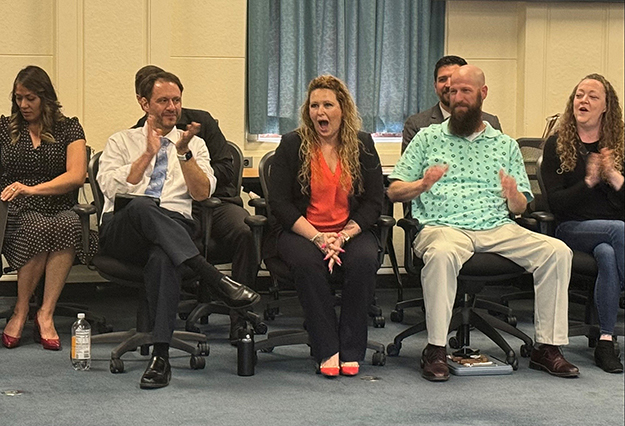JOINT BASE LEWIS-McCHORD - The finalists in a campaign designed to help civilian employees have a voice in improving operations at Joint Base Lewis-McChord pitched their ideas to a panel of decision-makers May 30.
Major General Matthew McFarlane, I Corp deputy commander, Col. Kent Park, JBLM commander, Col. Patrick McClintock, 62nd Operations Group commander, Command Sgt. Maj. Sebastian Camacho, 1st Multi-Domain Task Force command sergeant major, and John Bulldis, 62nd Airlift Wing director of staff, made up the panel that heard presentations from five finalists and ultimately chose the solution they believed would best benefit the installation.
The finalists were selected from 52 submissions received between March 15 and April 15 following a request from JBLM headquarters for fresh ideas on ways to bring positive change to civilian workforce processes at the installation.
"I'm really excited to take part in today," McFarlane said at the start of the event. "The Army has a tendency to do it the way we've always done it around here, and while we like to think the Army is good with change ... it's actually not. We have one of the largest bureaucracies in the world, so your ideas help us chip away at those challenges, those firewalls we have, to really drive meaningful change, to gain efficiencies and make us all more effective at what we do."
Suggestions varied from ways to increase the quality of goods and services produced while simultaneously conserving energy, to making user-friendly upgrades on different government websites and even utilizing social media to increase recruitment efforts.
While not the winning submission, Gena Colby and Ryan Holland's suggestion to streamline MyPay for Non-Appropriated Fund employees was a close second place, according to the panel.
The pair traveled from the Yakima Training Center where they work for Morale, Welfare and Recreation, to pitch their suggestion and shed light on the troubles that NAF employees face with simple changes to their MyPay accounts and profiles. Unlike GS employees, NAF employees do not have the ability to edit their information or change their retirement pay allotments.
"It can be something as simple as a change of address," Colby said. "But we cannot go in and edit our information. We must submit paperwork to a representative and wait for an HR employee somewhere to make the change, and it can take months before it's completed."
Colby shared her own experience for an example.
"In August, I elected to start my 401(k)," Colby said. "I put the paperwork in and have done countless communications since then. I still do not have a 401(k)."
The winning suggestion agreed upon by the panel came from Jennifer Pfeiffer, housing manager with JBLM's Directorate of Public Works. Pfeiffer presented an alternative to paper sign-in sheets, explaining that the time-consuming efforts that are involved with sign-in sheets could be resolved with a simple scanner or even QR code that connects to a service member's Department of Defense information.
Pfeiffer estimated that for clients coming into the housing office, it takes approximately three minutes to go through the sign-in process, and then that information has to be manually entered into a computer database by housing employees.
"We see almost 30,000 visitors at the housing office in one year," Pfeiffer said. "So, if it takes three minutes to sign each person in to find out what they are there for, that's 1,420 hours of time that could be saved each year."
Pfeiffer estimated it takes around 20 minutes to create a simple QR code that can be scanned by a smartphone, and she said virtually all organizations at JBLM could benefit from the transition away from paper sign-in forms.
"I'm just shocked that this isn't already in place, honestly," Bulldis said. "If everybody who comes on base from the age of 12 and up has an ID card that has the ability to be scanned to capture that information, I just think it would be a great improvement."
Being selected as the winning submission means that Pfeiffer's idea could become a reality across the base. She'll also receive a cash award for submitting the winning idea.
"It will be given full support from the garrison to put into action," Park said. "In fact, all these suggestions were so great we will continue to look at each of them to see if we could implement them in some way."
The idea for the JBLM Solve It came from Park, who said he hopes to see it become an annual event.




Read Comments